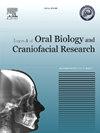Taste perception and muscular response: EMG based experimental evaluation
Q1 Medicine
Journal of oral biology and craniofacial research
Pub Date : 2025-03-11
DOI:10.1016/j.jobcr.2025.02.016
引用次数: 0
Abstract
Background
Taste perception influences not only flavor preference but also the physiological processes of chewing and digestion. Each primary taste—sweet, sour, salty, bitter, and umami—affects specific receptors and shapes masticatory muscle activity, notably in the temporalis and masseter muscles. Limited research exists on how taste affects muscle synergy (coordinated activation) and symmetry (balanced activation) in chewing. Using surface electromyography (EMG), this study examines how different tastes impact these muscle dynamics, offering insights relevant to dentistry, nutrition, and food science.
Methods
This study included five healthy participants aged 18–22 years. EMG recordings were conducted on the temporalis anterior and masseter muscles. Each participant chewed five distinct jelly formulations (sweet, sour, salty, bitter, umami) prepared with standardized flavours. The muscle activity was analyzed to determine the effects of taste on muscle synergy (right and left temporalis and masseter) and symmetry (temporalis and masseter). Paired t-tests and ANOVA were used to assess statistical significance.
Results
The results revealed taste-dependent variations in muscle synergy and symmetry. Sweet and salty tastes increased muscle synergy, while bitter and umami decreased it. Minimal changes were observed in the symmetry of the temporalis muscle across taste conditions, while the symmetry of the anterior masseter showed notable variations, especially with salty and umami. However, statistical analysis indicated no significant differences in muscle synergy or symmetry between jelly and non-jelly conditions across all taste stimuli (p > 0.05).
Conclusion
This study underscores the complexity of the neuromuscular response to taste perception, suggesting potential subtle influences of taste on muscle activity. Future research with a larger sample size and advanced statistical methods may further elucidate the role of taste in modulating masticatory muscle function.
味觉和肌肉反应:基于肌电图的实验评估
味觉感知不仅影响味觉偏好,还影响咀嚼和消化的生理过程。每一种主要的味觉——甜、酸、咸、苦和鲜味——都会影响特定的感受器并影响咀嚼肌的活动,尤其是颞肌和咬肌。关于味觉如何影响咀嚼时肌肉协同(协调激活)和对称(平衡激活)的研究有限。利用肌电图(EMG),本研究考察了不同口味如何影响这些肌肉动力学,为牙科、营养学和食品科学提供了相关见解。方法本研究纳入5名年龄在18-22岁的健康受试者。对颞前肌和咬肌进行肌电图记录。每个参与者咀嚼五种不同的果冻配方(甜、酸、咸、苦、鲜味),用标准的味道准备。分析肌肉活动,以确定味觉对肌肉协同作用(左右颞肌和咬肌)和对称性(颞肌和咬肌)的影响。采用配对t检验和方差分析评估统计学意义。结果显示肌肉协同和对称性的味觉依赖性变化。甜味和咸味增加了肌肉协同作用,而苦味和鲜味则降低了肌肉协同作用。颞肌的对称性在不同的味觉条件下变化很小,而前咬肌的对称性则表现出显著的变化,尤其是在咸味和鲜味的情况下。然而,统计分析表明,在所有味觉刺激下,果冻和非果冻条件下的肌肉协同作用或对称性没有显著差异(p >;0.05)。结论本研究强调了味觉神经肌肉反应的复杂性,提示味觉对肌肉活动的潜在微妙影响。通过更大的样本量和先进的统计方法,未来的研究可能会进一步阐明味觉在调节咀嚼肌功能中的作用。
本文章由计算机程序翻译,如有差异,请以英文原文为准。
求助全文
约1分钟内获得全文
求助全文
来源期刊

Journal of oral biology and craniofacial research
Medicine-Otorhinolaryngology
CiteScore
4.90
自引率
0.00%
发文量
133
审稿时长
167 days
期刊介绍:
Journal of Oral Biology and Craniofacial Research (JOBCR)is the official journal of the Craniofacial Research Foundation (CRF). The journal aims to provide a common platform for both clinical and translational research and to promote interdisciplinary sciences in craniofacial region. JOBCR publishes content that includes diseases, injuries and defects in the head, neck, face, jaws and the hard and soft tissues of the mouth and jaws and face region; diagnosis and medical management of diseases specific to the orofacial tissues and of oral manifestations of systemic diseases; studies on identifying populations at risk of oral disease or in need of specific care, and comparing regional, environmental, social, and access similarities and differences in dental care between populations; diseases of the mouth and related structures like salivary glands, temporomandibular joints, facial muscles and perioral skin; biomedical engineering, tissue engineering and stem cells. The journal publishes reviews, commentaries, peer-reviewed original research articles, short communication, and case reports.
 求助内容:
求助内容: 应助结果提醒方式:
应助结果提醒方式:


